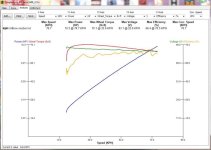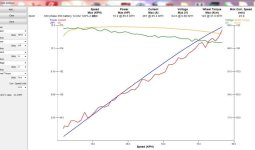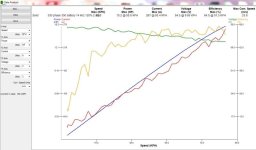Ok so this is it I have been working up to this for ~8 years and have had plans for my own dyno since I was about 18 (~16 years ago)
I first made a RC car dyno out of a couple rollers to get a feel for it. I ordered an electronics set from dyno 46 and it worked ok on the right computer for a while.
Then as I was shopping for something that would suit my needs I was looking pretty hard at Performance trends products when Dr.Bass showed me the simple dyno free to use software. I have since worked with Damon form simple dyno and added a current sensor and voltage input via a Arduino uno board. I can configure the inputs for temperature and Air fuel among other things. So far everything is working pretty well I just used a VR senor on a motorcycle sprocket for the signal this feed into the mic port on my laptop I wanted as many teeth per roller rpm as the software would allow for a better low speed full power start reading with the electrics.
https://sites.google.com/site/simpledyno/home
This is the very start >[youtube]XdjQ445WoJw[/youtube]
This is the rc dyno modded to run scooters. > [youtube]09dtmRzcRLQ[/youtube]
I used the compressor motor running though a 50:1 reduction box then with a chain and sprockets to get the rpm where I wanted it!
Diy machining who needs a lathe? > [youtube]6PHoKwk8h_A[/youtube]
And the final knurl finished today. > [youtube]7yDuN-bgXTo[/youtube]
Drift trike on the dyno.> Also before putting a better knurl on the roller. [youtube]kC97BLvGr7s[/youtube]
This is a run with the ysr before adding the better knurl which required very tight strapping on the rear wheel to keep it from slipping. That will also contribute to the 4000-5000 watts at max speed and full rpm with out any more acceleration at the end of the run.
[youtube]3Z2WcchbHXU[/youtube]
I first made a RC car dyno out of a couple rollers to get a feel for it. I ordered an electronics set from dyno 46 and it worked ok on the right computer for a while.
Then as I was shopping for something that would suit my needs I was looking pretty hard at Performance trends products when Dr.Bass showed me the simple dyno free to use software. I have since worked with Damon form simple dyno and added a current sensor and voltage input via a Arduino uno board. I can configure the inputs for temperature and Air fuel among other things. So far everything is working pretty well I just used a VR senor on a motorcycle sprocket for the signal this feed into the mic port on my laptop I wanted as many teeth per roller rpm as the software would allow for a better low speed full power start reading with the electrics.
https://sites.google.com/site/simpledyno/home
This is the very start >[youtube]XdjQ445WoJw[/youtube]
This is the rc dyno modded to run scooters. > [youtube]09dtmRzcRLQ[/youtube]
I used the compressor motor running though a 50:1 reduction box then with a chain and sprockets to get the rpm where I wanted it!
Diy machining who needs a lathe? > [youtube]6PHoKwk8h_A[/youtube]
And the final knurl finished today. > [youtube]7yDuN-bgXTo[/youtube]
Drift trike on the dyno.> Also before putting a better knurl on the roller. [youtube]kC97BLvGr7s[/youtube]
This is a run with the ysr before adding the better knurl which required very tight strapping on the rear wheel to keep it from slipping. That will also contribute to the 4000-5000 watts at max speed and full rpm with out any more acceleration at the end of the run.
[youtube]3Z2WcchbHXU[/youtube]





